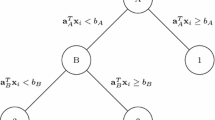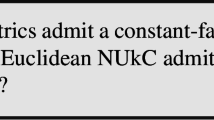Abstract
For variables (x,y,z) in [0, 1]3, three functionsA(y,z),B(z,x),C(x,y), with values in [0, 1], are to be chosen to minimize the integral, over (x,y,z) in the unit cube, ofAB+BC+CA, subject to prescribed values for the integral of each function. It is shown that a minimum can be achieved by dividing each of thex,y,z intervals into three or fewer subintervals and taking each ofA,B,C as indicator function of the union of some of the nine (or fewer) rectangles into which this divides its domain. Several specializations and generalizations of this problem are given consideration. It can be considered as a decision problem with distributed information.
Similar content being viewed by others
References
Chung, F. R. K., Private Communication, 1983.
Witsenhausen, H. S.,Team Guessing with Lacunary Information, Mathematics of Operations Research, Vol. 8, pp. 110–121, 1983.
Hardy, G. H., Littlewood, J. E., andPolya, G.,Inequalities, Cambridge University Press, Cambridge, England, 1934.
Mitrinović, D. S.,Analytic Inequalities, Springer Verlag, Berlin, Germany, 1970.
Author information
Authors and Affiliations
Additional information
Communicated by P. Varaiya
Rights and permissions
About this article
Cite this article
Witsenhausen, H.S. The cyclic minimum correlation problem. J Optim Theory Appl 54, 143–155 (1987). https://doi.org/10.1007/BF00940409
Issue Date:
DOI: https://doi.org/10.1007/BF00940409




